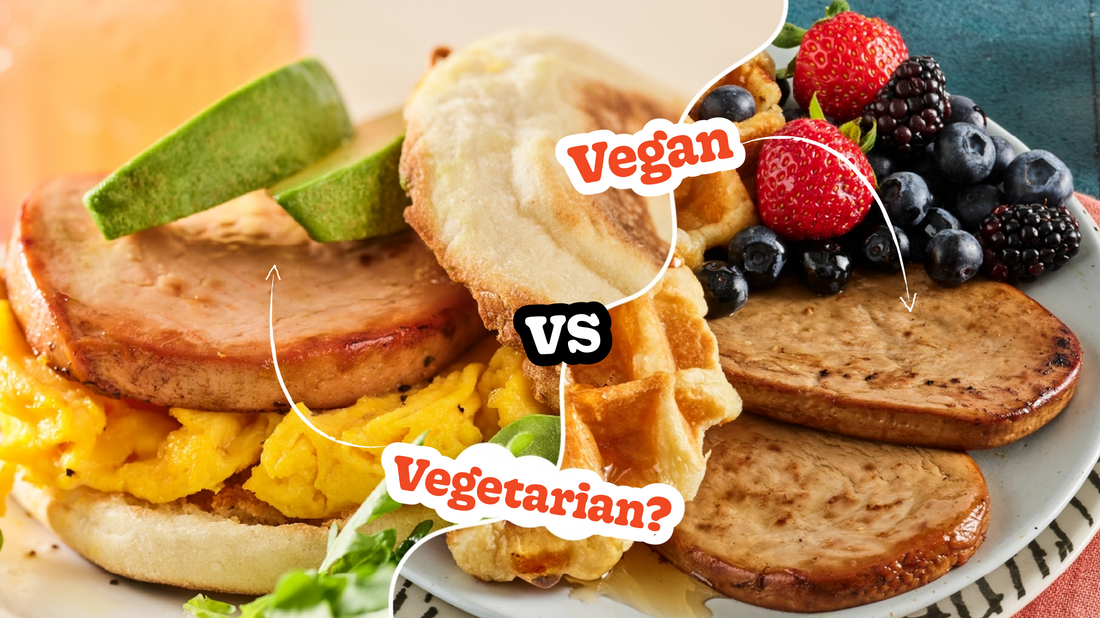

What’s the Difference Between Vegan and Vegetarian?
Summary
- Vegetarianism excludes meat, poultry, and fish but may include dairy, eggs, and honey, while veganism avoids all animal-derived products.
- Veganism extends beyond diet to exclude animal-based materials like leather, while vegetarianism focuses primarily on food.
- Both diets support health and sustainability, but veganism typically has a lower environmental footprint.
- Mycelium, used in Meati’s products, provides a sustainable, protein-rich vegan alternative that mimics the texture of meat.
- Choosing between vegan and vegetarian depends on your ethical priorities and dietary flexibility.
Choosing a plant-based lifestyle can feel like navigating a maze of terms and choices. Two of the most common paths, veganism and vegetarianism, offer distinct approaches to eating and living.
While both prioritize plant-based foods, their differences in diet, lifestyle, and motivations set them apart. This guide clarifies the distinctions.
Definitions & Core Differences
Vegetarian Diet
A vegetarian diet typically excludes meat, poultry, fish, and seafood, but often includes animal-derived foods such as dairy products (milk, cheese, yogurt), eggs, and honey. Variations like lacto-vegetarian (no eggs, includes dairy) or ovo-vegetarian (no dairy, includes eggs) offer flexibility.
People choose vegetarianism for health reasons, like reducing cholesterol, or ethical concerns, such as minimizing harm to animals. Environmental motivations also play a role, as plant-based diets reduce reliance on resource-intensive livestock farming.
Vegan Diet
Veganism takes a stricter stance, excluding all animal-derived products meat, poultry, fish, dairy, eggs, honey, and even ingredients like gelatin or whey. Beyond food, vegans often avoid non-food items like leather, wool, silk, or cosmetics tested on animals.
The primary motivation is often ethical, rooted in opposition to animal exploitation. Still, many also embrace veganism for its environmental benefits, like lower greenhouse gas emissions, or health advantages, such as reduced saturated fat intake.
Key Differences at a Glance
Food Exclusions
Vegetarians avoid meat, poultry, and fish but may enjoy dairy products like yogurt or cheese, eggs for baking, or honey in tea. Vegans, however, eliminate all animal-derived foods, including subtle ingredients like whey in processed snacks or gelatin in desserts, requiring careful label-checking to stay true to the diet.
Lifestyle Scope
Vegetarianism is primarily a dietary choice, focusing on what’s on the plate. Veganism extends further, influencing clothing (e.g., choosing cotton over leather), cosmetics (cruelty-free only), and household goods. This makes veganism a broader lifestyle commitment beyond just food.
Flexibility
Vegetarianism offers subcategories for flexibility; lacto-vegetarians enjoy dairy, while ovo-vegetarians include eggs. This adaptability suits those who want plant-based eating without eliminating animal products. Veganism, by contrast, is an all-or-nothing approach, with no animal-derived products permitted, making it stricter but more consistent for those prioritizing ethics.
Health & Environmental Considerations
Health
Both diets can be nutritious with proper planning. Vegetarians may need to monitor iron and B12 levels if dairy or egg intake is low, as these nutrients are less abundant in plant foods. Vegans require extra attention to B12, iron, and omega-3s, often through fortified foods or supplements.
Environment
Vegan diets generally have a lighter environmental footprint due to their complete avoidance of animal agriculture, which demands significant water, land, and energy. Vegetarian diets, while still eco-friendly compared to omnivorous ones, rely on dairy and egg production, which can strain resources.
Protein Sources: Spotlight on Mycelium
Mycelium, the nutrient-rich root structure of mushrooms, is revolutionizing vegan protein. meati™'s products, made from 95% mycelium, deliver a complete protein packed with fiber, B9, and zinc, mimicking meat’s texture and flavor.
Unlike traditional farming, mycelium production requires minimal water and land, making it a sustainable choice. For example, meati™'s Southwest Style Steak sears like beef and satisfies cravings for tacos, while its Crispy Cutlet rivals chicken in restaurant dishes at places like Birdcall.
This versatility makes mycelium ideal for vegan burgers, steaks, or cutlets, offering a hearty, umami-packed alternative that elevates plant-based eating.
How to Choose Between Vegan & Vegetarian?
Choosing between veganism and vegetarianism depends on your priorities. Ask yourself:
Are ethical concerns about animal products a priority? If avoiding all animal exploitation, food, clothing, and beyond matters most, veganism aligns best. meati™'s mycelium-based products make this choice delicious and sustainable.
Do you want flexibility with dairy or eggs? If you enjoy cheese or scrambled eggs and aren’t ready to give them up, vegetarianism offers a flexible starting point.
Tip: Vegetarianism can be a stepping stone to veganism. Start by swapping meat for meati™'s Classic Cutlet in your favorite recipes to ease the transition while enjoying crave-worthy flavors.
Final Word
Vegetarianism and veganism both offer paths to healthier, more sustainable eating, but they differ in scope and commitment. Vegetarianism avoids meat but allows dairy, eggs, and honey, while veganism excludes all animal products, extending to lifestyle choices.
With innovations like meati™'s mycelium-based proteins, veganism is more accessible and delicious than ever, delivering juicy, nutrient-packed options that support your body and the planet. Whether you’re exploring vegetarianism or diving into veganism, proper planning ensures that both diets are rewarding.
Ready to fuel your day with plant-powered protein? Discover meati™'s juicy, sustainable cutlets and steaks.
“Food is a choice. Choose one that nourishes your body and the planet with every delicious bite.”
